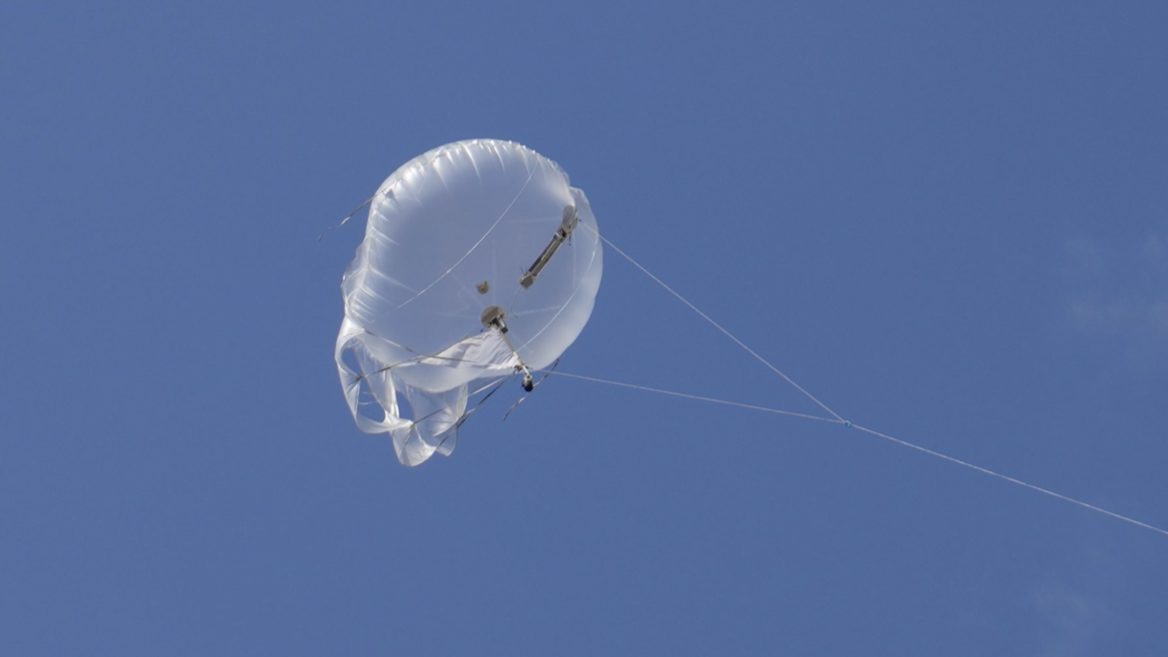Ukraine has developed an innovative balloon-carried electronic surveillance system, dubbed Aero Azimuth, designed to enhance its capabilities in detecting and neutralizing enemy drone operators.
The Aero Azimuth system was developed by the Ukrainian company Kvertus, known for its expertise in electronic warfare technologies. The airborne system was recently showcased at a “Protect Warrior from Drone” event, an initiative organized by Kvertus to demonstrate the latest in counter-drone innovations.
The Aero Azimuth system, while originally ground-based, has been adapted for airborne deployment for the first time.
The system is integrated with an aerostat provided by another Ukrainian company, Aerobavovna, enabling it to operate from the sky.
These aerostats are reportedly engineered to remain airborne for up to seven days without refueling, withstand wind speeds of up to 15 meters per second, and carry payloads ranging from four to 25 kilograms. They are most effective when flown at altitudes between 300 and 700 meters.
In addition to the aerostat, a balloon-like structure, the system incorporates a range of supporting tools, including a trailer-mounted winch, a gas cylinder system, and maintenance equipment.
Once deployed, the Aero Azimuth system can be positioned approximately nine kilometers from the front lines, where it operates across various low and medium altitudes.
Despite the relatively shallow depth of deployment, the system’s passive nature makes it difficult to detect, even with optical reconnaissance, which could be further complicated by the busy “drone air traffic” in the conflict zones.
One of the standout features of the Aero Azimuth system is its impressive detection range. When the aerostat is raised to a standard operational altitude, it can detect radio signals from enemy drone operators up to 60 kilometers away.
The system can also triangulate these signals within a range of 24 to 30 kilometers, providing precise locations of the operators. This capability is crucial for Ukrainian forces as it allows them to target the operators directly, disrupting enemy drone operations more effectively.
Moreover, the prolonged airborne presence of the aerostats enables the creation of a dense and cost-effective network for electronic, radar, and optical reconnaissance.
This persistent surveillance not only enhances situational awareness but also serves as a network of signal repeaters, extending the reach of Ukraine’s electronic warfare capabilities. However, it is still not known whether Ukrainian forces have begun using this system.
Drone Crew: Essential Combat Units
In a conflict increasingly defined by the widespread use of drones and electronic warfare, the Aero Azimuth system marks a crucial advancement in Ukraine’s defense capabilities.
Despite numerous efforts to develop kinetic and non-kinetic countermeasures against drones and entirely passive defenses, the Aero Azimuth system (and its ground-based counterpart) offers a distinct advantage.
Unlike other systems that target individual drones, Aero Azimuth focuses on detecting and locating the drone operators themselves. This approach addresses the fundamental source of the drone threat, providing a more strategic and effective solution.
This development is especially relevant given the growing threat posed by various types of drones, particularly the rapidly proliferating first-person view (FPV) models.
FPV drone crews have become integral to frontline combat operations, facing similar risks and responsibilities as traditional soldiers. Their role has also evolved to resemble that of mortar teams, where they must rapidly deploy, execute their tasks, and then relocate to avoid being targeted.

These crews, much like light and medium mortar teams, are highly vulnerable to enemy fire during these critical moments, as their positions can be easily tracked through traditional counter-battery methods or visual reconnaissance.
This has spurred efforts on both sides to either protect their FPV units or eliminate the enemy’s. For instance, last year, EurAsian Times reported that the Russian industry had developed a drone designed to shield FPV drone operators from enemy reconnaissance.
Meanwhile, aerostats are a well-established tool for reconnaissance, and their use in combat is not new. Reports indicate that Russia and Ukraine procure and deploy aerostats.
Earlier this year, reports indicated that Russia had deployed stationary aerostats in Karelia. These aerostats are equipped with sophisticated monitoring technology and are intended for surveillance activities over Finland.
EurAsian Times previously reported that Russian forces have employed balloons equipped with radar reflectors to confuse Ukrainian air defense systems.
Additionally, there have been claims of Ukraine using inexpensive ‘balloon bombs’ for strikes over the border. The Ukrainian Armed Forces possess a specialized unit that is tasked with the operation of aerostats.
- Contact the author at ashishmichel(at)gmail.com
- Follow EurAsian Times on Google News




